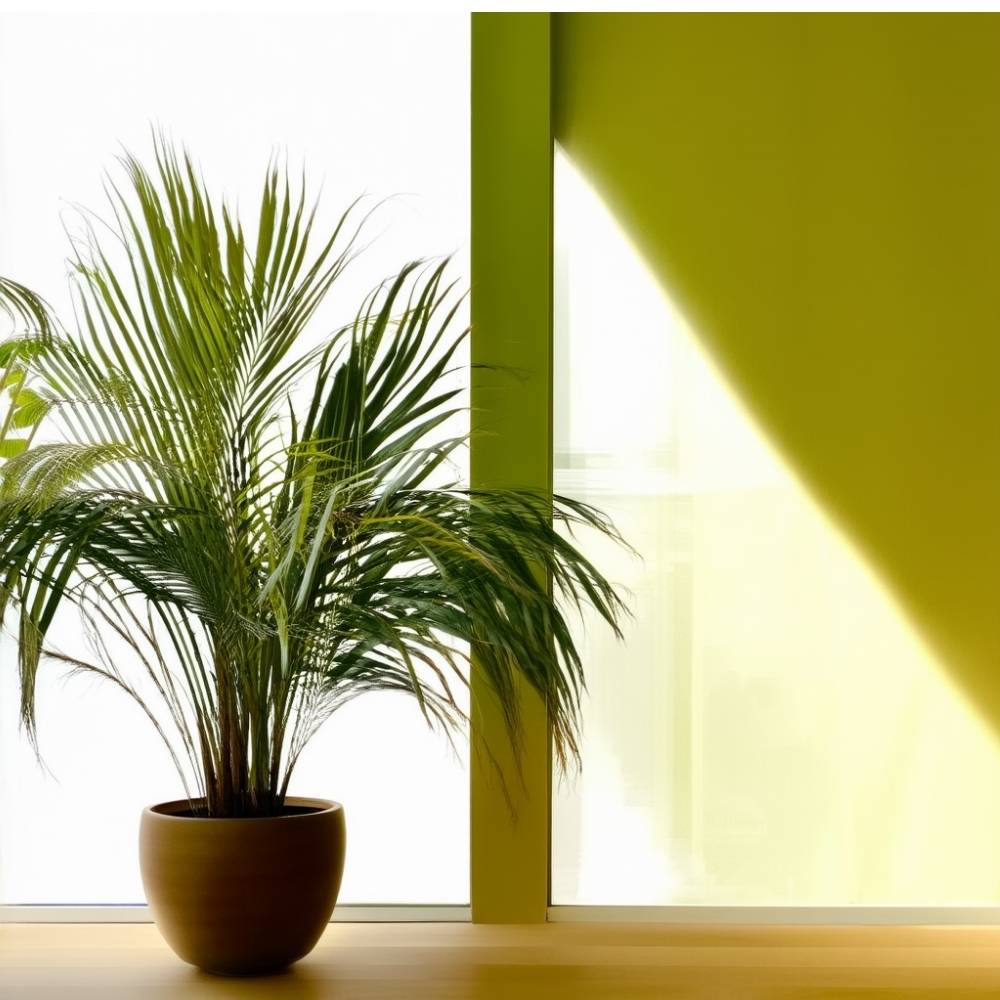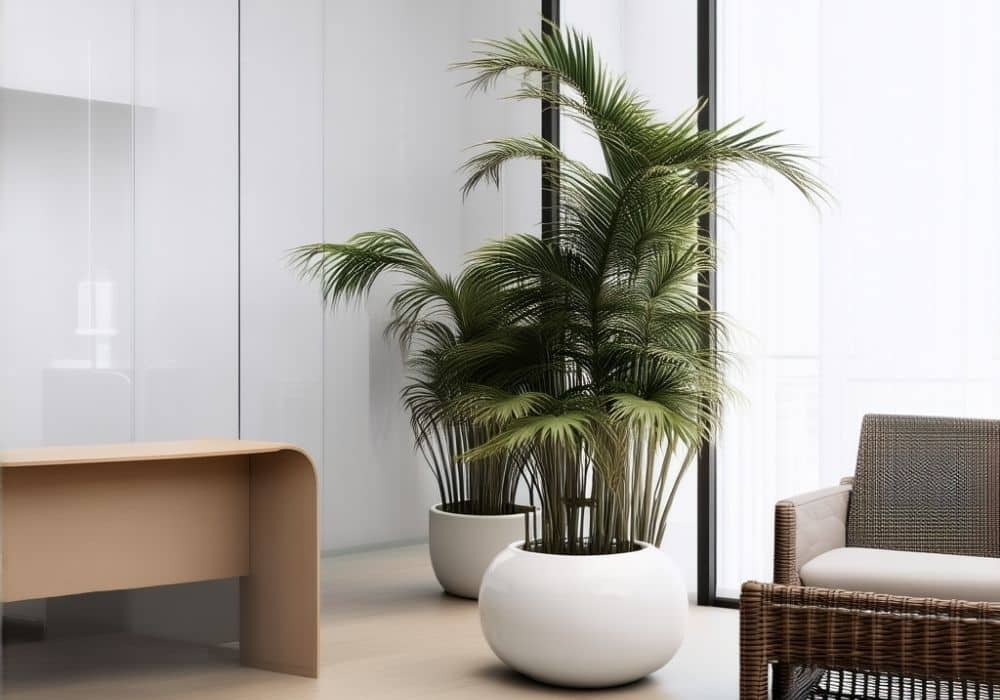Areca Palm (Dypsis lutescens)
Have you ever wished you could step into a lush, tropical paradise—without leaving your living room? With the Areca Palm (Dypsis lutescens), also known as the Butterfly Palm or Golden Cane Palm, you can do just that. This beautiful, air-purifying houseplant is famous for its feathery fronds, vibrant green color, and the sense of calm it brings to any space. In this guide, you’ll learn everything you need to know about Areca Palms: from their origins and varieties to easy care tips, troubleshooting, and creative ways to style them in your home.
What Makes the Areca Palm So Special?

The Areca Palm offers more than just its attractive appearance. It’s one of the most popular indoor plants for a reason:
- Tropical Beauty: Its long, feather-like fronds instantly evoke the feeling of a serene, sun-dappled rainforest.
- Natural Air Purifier: Areca Palms work hard to clean the air, removing toxins and increasing humidity.
- Pet-Friendly: Safe for cats, dogs, and other pets, making it a worry-free choice for animal lovers.
- Easy to Grow: With just a little care, this palm can thrive and grow for years, adding a fresh vibe to your home.
Let’s dive deeper into the world of Areca Palms and discover how you can make this tropical gem flourish in your space.
Defining the Areca Palm: Feather-Like Fronds and Upright Clumps
The first thing you’ll notice about an Areca Palm is its graceful, arching fronds. Each frond is made up of dozens of narrow, pointed leaflets, giving the plant a soft, feathery look. The stems are slender and often have a golden-yellow hue—hence the nickname “Golden Cane Palm.” Unlike some other palms, the Areca grows in dense clumps. New shoots sprout from the base, creating a bushy, full appearance that looks stunning from every angle.
Key features:
- Multi-stemmed, bushy growth
- Long, arching fronds (can reach up to 6-7 feet indoors!)
- Golden-yellow stems and lively green leaves
- Soft, airy canopy that adds elegance to any room
The Origins of the Areca Palm: Madagascar’s Tropical Treasure
Did you know your Areca Palm has roots in Madagascar? In the wild, these palms grow along riverbanks and in sunny clearings, soaking up warmth and high humidity. They’re used to tropical forest conditions—think dappled sunlight, moist air, and rich, well-draining soil. Knowing where they come from is the secret to keeping them happy at home!
Areca Palm’s natural preferences:
- Warmth (ideally 18-24°C / 65-75°F)
- High humidity
- Bright, indirect light (like sunlight filtering through forest trees)
- Moist, but not soggy, soil
What’s in a Name? Areca, Butterfly, and Golden Cane
You might see Areca Palms called by several names:
- Areca Palm: The most common name, though technically “Areca” is a different palm genus.
- Butterfly Palm: Because the fronds look like butterfly wings as they arch outwards.
- Golden Cane Palm: Thanks to those beautiful yellowish stems that glow in the sun.
No matter what you call it, the Areca Palm’s real charm is its ability to bring a soft, tropical vibe to your home while working quietly as a natural air purifier.
Types and Varieties of Areca Palms
The Classic Areca Palm (Dypsis lutescens)
This is the superstar of the houseplant world. With multiple slender stems and lush, arching fronds, it’s the variety you’ll see most often in stores and homes. When well cared for, it can grow impressively tall indoors.
“Baby” or “Dwarf” Areca Palms
Sometimes, you’ll see small Areca Palms labeled as “dwarf” or “baby” varieties. Most of the time, these are simply young plants that will grow bigger over time. True dwarf cultivars are rare in regular garden centers.
Frond Color and Texture
Areca Palm fronds are typically a bright, lively green. You might spot a golden or yellowish tint on the stems and leaf stalks, adding warmth and character. The leaflets are narrow and arranged in a way that gives the whole plant a soft, flowing look.
Growth Habits: Clumping and Arching
Areca Palms grow in a clumping habit—new shoots pop up from the base, making the plant fuller and bushier as it matures. The fronds arch outwards, giving the palm its signature “butterfly” appearance.
How to Care for an Areca Palm: Simple Steps for Lush Growth
Areca Palms are fairly easy to care for, but like all beautiful things, they do have a few preferences. Here’s Tips to keep your Areca Palm in top shape:
1. Light: Bright, Indirect Sunlight
Areca Palms love bright, indirect light. Imagine the gentle sunlight under a forest canopy. Excessive direct sunlight can burn the leaves, leading to yellow or brown tips. Gentle morning light is acceptable, but it’s best to shield the plant from intense afternoon sun. East or west-facing windows are usually perfect.
Pro tip: If your palm is in a dark corner, it may grow slowly or look leggy. Move it closer to a window or use a grow light if needed.
2. Water: Keep Soil Moist, Not Soggy
Consistency is key. Water your Areca Palm when the top 1-2 inches (2.5-5 cm) of soil feel just dry. Water thoroughly, letting excess drain out the bottom of the pot. Avoid letting the plant sit in standing water, as overly wet soil can cause root rot.
- Water less frequently during the winter months when the plant’s growth naturally slows down.
- If your tap water contains high levels of chlorine or fluoride, opt for filtered or distilled water instead.
3. Temperature and Humidity: Warm and Moist
Areca Palms thrive in warm, humid conditions. Keep the temperature between 65-75°F (18-24°C) and away from cold drafts or sudden temperature changes. Humidity is crucial: If the air is dry (especially in winter), you may see brown tips on the fronds.
How to boost humidity:
- Use a humidifier nearby
- Set the pot on a tray filled with water and pebbles to increase humidity around the plant.
- Mist the fronds regularly (with distilled water to prevent mineral spots)
- Group plants together to create a mini rainforest effect
4. Soil and Potting: Well-Draining and Slightly Acidic
Choose a well-draining, slightly acidic potting mix. A blend of quality potting soil, perlite, peat moss, or coco coir works well. Always use a pot with drainage holes. Areca Palms like to be a little root-bound, so don’t rush to repot—every 2-3 years is usually enough. If you see roots emerging from the bottom, repot the plant in spring.
5. Fertilizer: Feed During the Growing Season
In spring and summer, nourish your Areca Palm every 2 to 4 weeks using a balanced liquid fertilizer diluted to half its recommended strength. You can also use a fertilizer made specifically for palms. Reduce or pause fertilizing during the fall and winter seasons.
Common Areca Palm Problems and How to Fix Them
Even tough plants like the Areca Palm can run into trouble. Here’s how to spot and solve common issues:
Brown Leaf Tips
Cause: Typically low humidity, use of harsh tap water, or accumulation of fertilizer.
Fixes:
- Increase humidity (humidifier, pebble tray, misting)
- Use distilled or filtered water
- Flush the soil thoroughly every few months to remove excess salts
Yellowing Fronds
Cause: Overwatering, not enough light, or nutrient deficiency (especially magnesium or iron).
Fixes:
- Check your watering routine (don’t let soil stay soggy)
- Relocate the plant to a brighter area that receives indirect sunlight.
- Feed with a balanced or palm-specific fertilizer
Drooping Fronds
Cause: Can be from underwatering (dry soil) or overwatering (soggy roots).
Fixes:
- Feel the soil. If it’s dry, water thoroughly. If it’s wet, let it dry out and check for root rot.
Pests: Spider Mites and Mealybugs
Signs: Webbing, sticky residue, or white cottony spots on fronds.
Fixes:
- Wipe leaves with a damp cloth
- Apply insecticidal soap or neem oil to treat the plant.
- Increase humidity to deter spider mites
Slow Growth
Cause: Not enough light, low nutrients, or the plant is root-bound.
Fixes:
- Move to a brighter spot
- Fertilize during the growing season
- Repot if roots are crowded
Areca Palm Dypsis lutescens and Pets: A Safe Choice For Your Furry Companions
One of the best things about the Areca Palm is that it’s non-toxic to cats, dogs, and horses, according to the ASPCA. This ensures it’s a safe option for households with inquisitive pets. While it’s always smart to discourage pets from eating plants (too much of any plant can upset their stomach), you can rest easy knowing the Areca Palm isn’t dangerous.
Areca Palm in Home Decor: Style and Air Quality All in One

The Areca Palm is a favorite among interior designers for good reason. Here’s what it adds to your living space:
Create a Tropical Oasis
Those feathery fronds instantly make any room feel like a calming retreat. Place one in your living room, bedroom, or bathroom for a touch of paradise.
Purify the Air
Areca Palms are famous for their air-cleaning abilities. Studies (including NASA’s Clean Air Study) show they help remove toxins like formaldehyde, benzene, and carbon monoxide from the air—making your home healthier and more comfortable.
Adds Height and Interest
With its upright, clumping growth, the Dypsis lutescens can reach up to 6-7 feet indoors, adding vertical interest and breaking up flat lines in your decor. It’s perfect for filling empty corners or framing windows.
Fits Any Decor Style
Whether your style is modern, bohemian, coastal, or traditional, the Areca Palm blends right in. Its natural elegance complements almost any color scheme or furniture style.
How to Propagate Areca Palms
Areca Palms naturally produce new shoots from their base. You can propagate by dividing these clumps during repotting:
- Carefully take the plant out of its pot.
- Separate a section of stems with roots attached.
- Plant the division in fresh soil that drains well.
- Keep in a warm, humid spot until established.
Propagation works best in spring, when the plant is actively growing.
Seasonal Care Tips
Spring & Summer
- As temperatures climb, increase both watering and humidity levels.
- Fertilize regularly.
- Repot if needed.
Fall & Winter
- Water less frequently, ensuring the soil never dries out entirely.
- Stop fertilizing.
- Watch for dry air from heaters—boost humidity as needed.
Areca Palm (Dypsis lutescens) FAQ: Your Questions Answered
Why are the tips of my Areca Palm turning brown?
Answer: This usually results from low humidity, harsh tap water, or an excess of fertilizer. Increase humidity, use distilled water, and flush the soil every few months.
How often should I water my Areca Palm?
Answer: When the top 1-2 inches of soil feel dry. Keep soil consistently moist but never soggy. Water less in winter.
Why are my Areca Palm’s fronds turning yellow?
Answer: Likely overwatering, not enough light, or a nutrient deficiency. Adjust watering, move to a brighter spot, and fertilize during the growing season.
Does the Areca Palm really need high humidity?
Answer: Yes! High humidity keeps fronds lush and prevents brown tips. Use a humidifier, pebble tray, or mist regularly.
Can I grow my Areca Palm outdoors?
Answer: In warm, frost-free climates (USDA zones 10-11), yes! Otherwise, keep it as a houseplant or bring it inside during cold weather.
Is the Areca Palm a good air purifier?
Answer: Absolutely. Areca Palms remove toxins from the air and add humidity, helping you breathe easier.
How tall can an Areca Palm get indoors?
Answer: With good care, 6-7 feet (1.8-2.1 meters) or more. It can also spread wide, making it a dramatic centerpiece.
When should I repot my Areca Palm?
Answer: Every 2-3 years, or when roots are growing out of the drainage holes. Spring is the most ideal season for repotting.
Why are my Areca Palm’s fronds drooping?
Answer: It may be caused by either insufficient or excessive watering. Check the soil—if dry, water thoroughly; if wet, let it dry out and check for root rot.
Final Thoughts: The Magic of the Areca Palm
The Dypsis lutescens is more than just a houseplant—it’s a living piece of paradise that brings beauty, tranquility, and cleaner air into your home. With its graceful fronds, easy-going nature, and air-purifying powers, it’s no wonder this palm is a favorite for both beginners and experienced plant lovers.
By providing bright, indirect light, regular watering, and plenty of humidity, you’ll enjoy the lush, tropical presence of your Areca Palm for years to come. Whether you want to create a relaxing oasis, improve your indoor air, or simply add a touch of green elegance to your space, the Areca Palm is your go-to plant.
Ready to transform your home with tropical vibes and fresher air? Bring home an Areca Palm and start your indoor paradise today!





